Jiuzhaigou is situated beside Provincial Highway 301, Zhangzha Town, Jiuzhaigou County, Aba Tibetan and Qiang Autonomous Prefecture, Sichuan Province. It is a World Natural Heritage site, a World Biosphere Reserve, and a national 5A-level tourist attraction.
Renowned for the saying "After visiting Jiuzhaigou, one need not admire other waters", Jiuzhaigou features a rich variety of water landscapes, including lakes, waterfalls, and shoal streams. The lake waters are vividly colored, resembling a fairy-tale realm. The scenic area is abundant in forest resources, with extensive coverage of primeval forests, a wide range of plant species, and numerous rare wild animals.
In terms of scenic architecture, the newly-built three-dimensional tourist service center at the valley entrance covers an area of 8.98 hectares, with a total construction area of approximately 30,000 square meters. Designed by the Architectural Design and Research Institute of Tsinghua University, it can serve a maximum of 41,000 tourists per day at the same time.
The total area of Jiuzhaigou Scenic Area is about 642.53 square kilometers, and most of the area is covered by forests.
History and Culture
Written records about Jiuzhaigou can be found in the Nanping County Chronicles compiled in the early years of the Republic of China. The archaeological excavation of the Ashaonao Ruins in 2008 confirmed that the history of human habitation in Jiuzhaigou dates back to the Han Dynasty, roughly 2,000 years ago. The Tibetan people who have lived here for generations believe in Bon, the primitive religion of the Tibetan region.
In the 1950s, surveyors from the National Forestry Ministry entered Jiuzhaigou and found that its total forest reserves amounted to 4 million cubic meters, with an exploitable area of 59,340 hectares. Subsequently, Jiuzhaigou went through a period of timber logging. Deforestation led to the drying up of "haizi" (a local term for lakes) and frequent geological disasters such as mudslides. It was not until the late 1970s that some insightful individuals and officials initiated calls for protection. In 1978, Qing Jianhua, Director of the Protection Department of the National Forestry Ministry, applied to the State Council for the establishment of a nature reserve in Jiuzhaigou, and since then, Jiuzhaigou has gradually embarked on a path of protection and development.
Major Scenic Spots
Wucai Pool (Five-Color Pool)
Wucai Pool is the smallest yet most color-rich "haizi" in Jiuzhaigou. Located in the southern section of Zechawa Valley, it sits at an altitude of 2,995 meters, with a length of 100.8 meters, a width of 56.8 meters, and a depth ranging from 6.56 to 9.43 meters. Under the sunlight, the lake water shimmers with a spectrum of colors, like a precious gem.
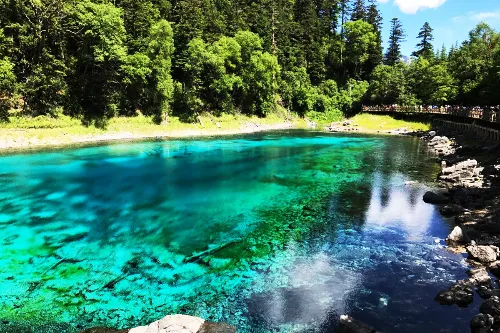
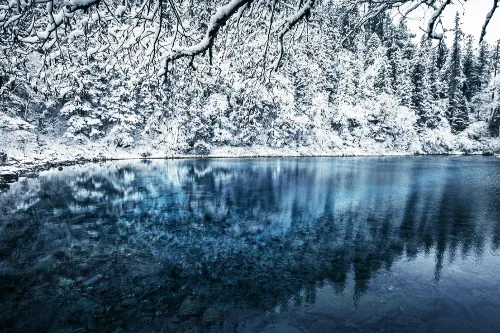
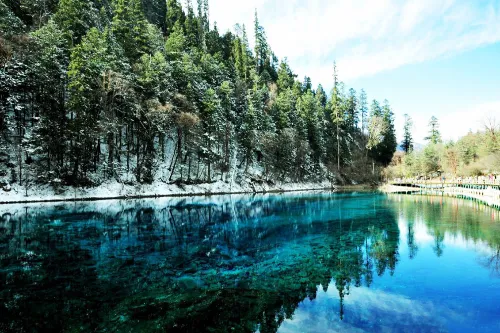
Changhai (Long Lake)
Changhai is the "haizi" with the highest altitude and the widest surface in Jiuzhaigou. It is located at an altitude of 3,060 meters and covers an area of approximately 2 million square meters. Shaped like an "S", the lake has crystal-clear blue water. Surrounded by rolling mountains, the distant snow-capped peaks are reflected in the lake, creating a magnificent landscape.
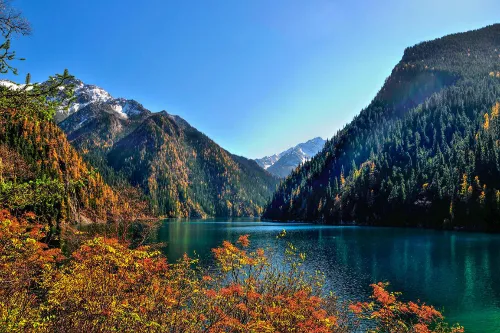
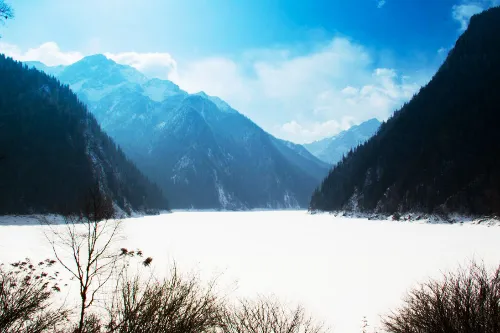
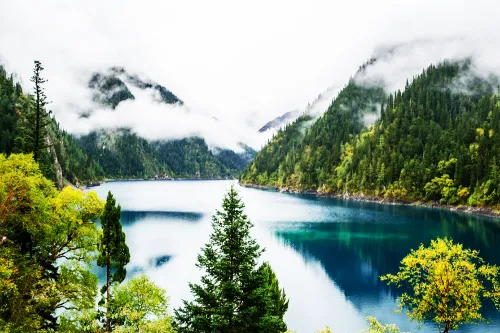
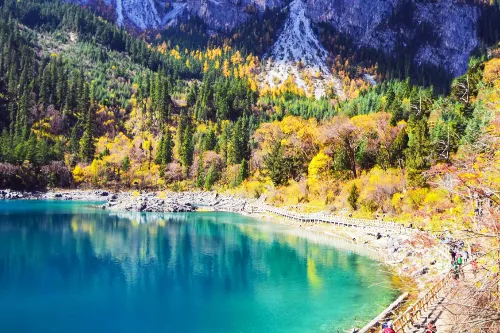
Shuzheng Qunhai (Shuzheng Group of Lakes)
Shuzheng Qunhai consists of 19 "haizi" of varying sizes and serves as the gateway to Jiuzhaigou's beautiful scenery. The lake water is so clear that the bottom is visible, and it displays different colors depending on the angle of sunlight and the depth of the water. Between the lakes, there are low travertine dikes, forming stepped waterfalls and cascading water landscapes.
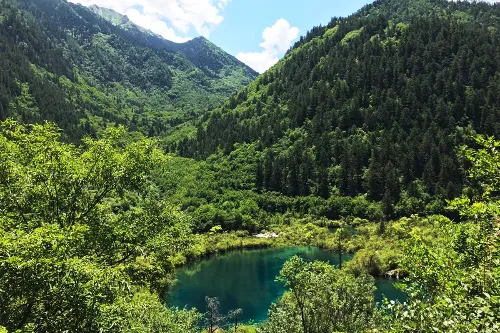
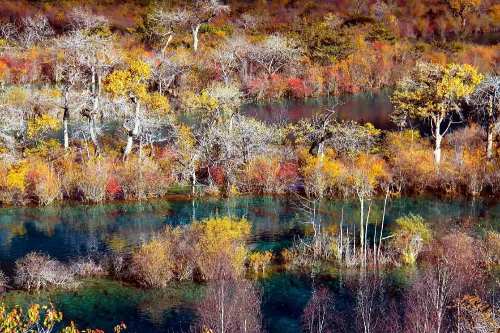
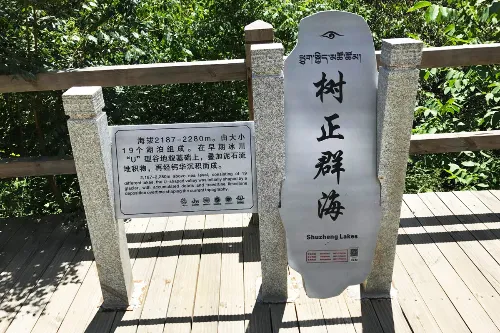
Nuorilang Waterfall
Nuorilang Waterfall is one of China's large travertine waterfalls. It has a width of 270 meters, a height of 24.5 meters, and is located at an altitude of 2,365 meters. The top of the waterfall is as flat as a platform, and water flows evenly down from it. Under the sunlight, rainbows are formed, presenting a spectacular view.
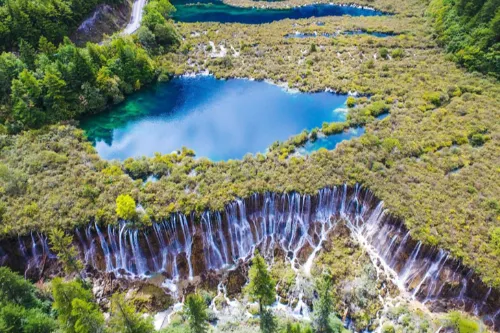
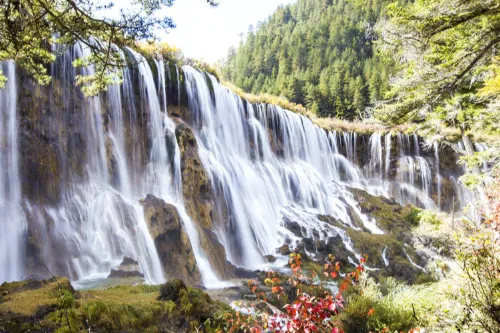
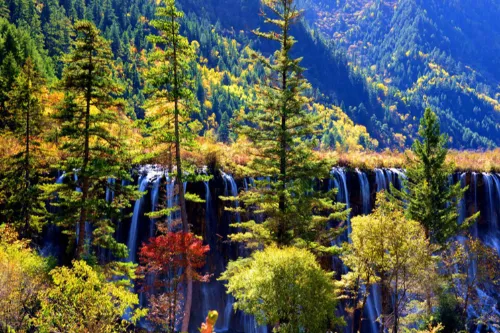
Wuhua Hai (Five-Flower Lake)
Wuhua Hai is known as "the most unique scenic spot in Jiuzhaigou" and "the essence of Jiuzhaigou". Located at the upper end of Kongque River in Rizegou Valley, it sits at an altitude of 2,472 meters with a water depth of 5 meters. The lake water exhibits a brilliant array of colors, like an oil painting. The trees on the bank are reflected in the water, complementing the lake and creating an incredibly beautiful scene.

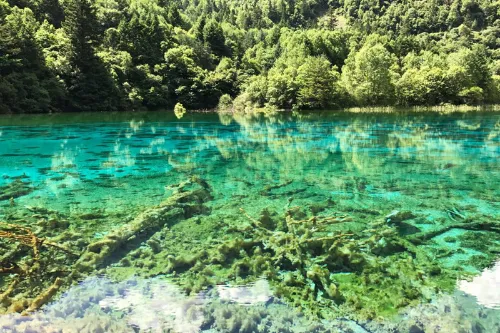
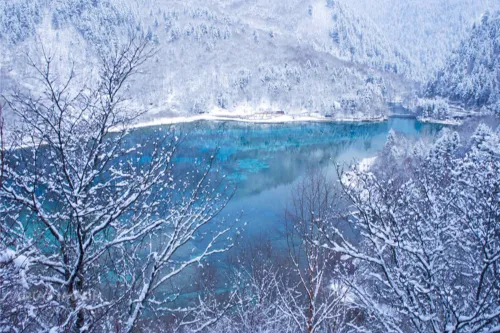
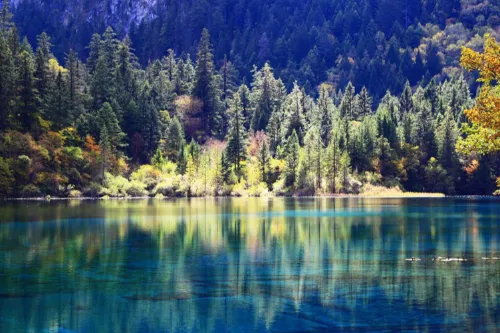
Penjing Tan (Bonsai Beach)
Penjing Tan, also known as "Penjing Sea" and called "Jiazhu Co" in Tibetan, is the first shoal stream landscape upon entering Jiuzhaigou. On the milky-white travertine shoal of Penjing Tan, various plants grow. The river water is clear and flows gently across the shoal, with mixed trees scattered throughout. Their roots are intertwined, and each tree forms a unique scene, just like a row of traditional Chinese bonsai.
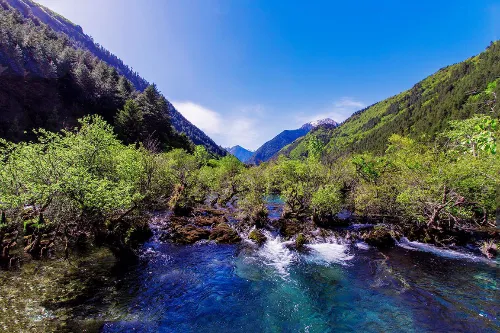
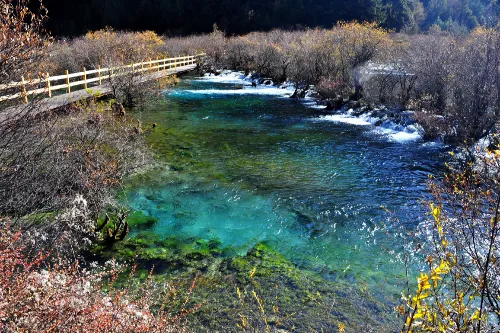
Luwei Hai (Reed Lake)
Luwei Hai is located at an altitude of 2,192 meters. With a height of approximately 15 meters and a width of about 10 meters, it is situated on the limestone cliff opposite the eastern side of Luwei Hai. Due to the natural weathering marks on the rocks and the decorative effect of plants, it forms the face of a graceful and beautiful girl, which is said to be the Woluosemo Goddess of Jiuzhaigou.
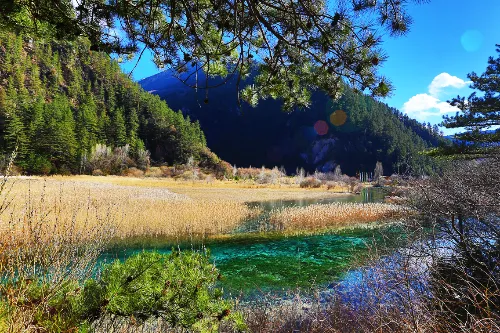
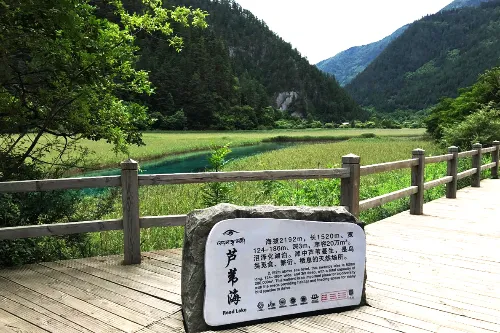
Zhenzhu Tan Waterfall (Pearl Beach Waterfall)
Zhenzhu Tan Waterfall is located at an altitude of 2,433 meters, with an average height of 21 meters and a width of 270 meters. It is formed from a moraine platform left by the Quaternary glaciation, which later underwent travertine formation, making the waterfall's slope more towering and stable. The back of the waterfall surface is concave in a crescent shape.
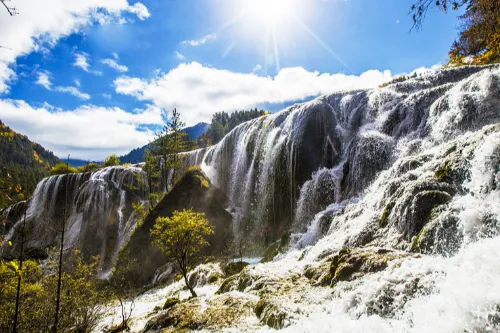
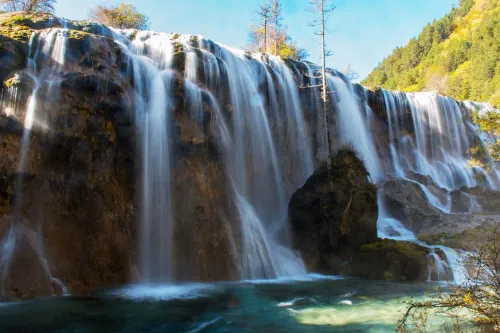
Zhenzhu Tan (Pearl Beach)
Located at an altitude of 2,450 meters, Zhenzhu Tan is the widest beach in Jiuzhaigou, with a width of 112.3 meters, a length of 189 meters, an average slope of 20 degrees, and a relative height difference of 15 meters. It is a large travertine accumulation platform formed by calcium carbonate deposition. This is the spot where Tang Seng and his disciples led horses through the water in the opening sequence of the TV series Journey to the West.
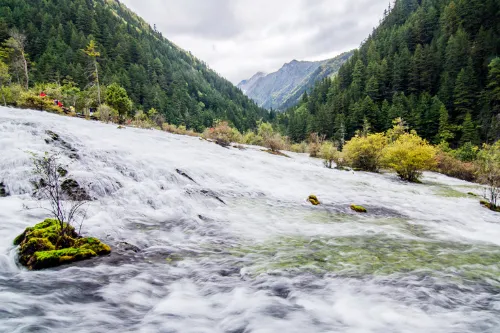
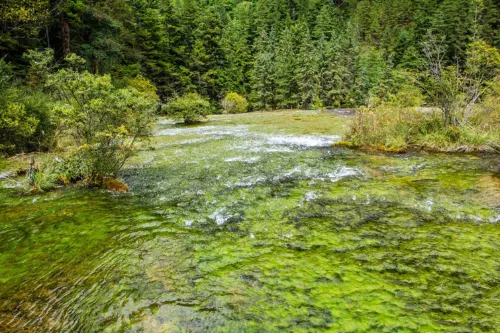
Recommended Tour Route
The scenic spots of Jiuzhaigou are mainly distributed in three valleys shaped like a "Y". Here is a recommended classic tour route: Take a sightseeing bus from the valley entrance to the Primeval Forest, then visit Jianzhu Bamboo Lake, Xiongmao Hai (Panda Lake), Wuhua Hai (Five-Flower Lake), Zhenzhu Tan Waterfall (Pearl Beach Waterfall), and Nuorilang Waterfall in sequence. Next, head to Zechawa Village to enjoy the views of Changhai (Long Lake) and Wucai Pool (Five-Color Pool). Finally, go downhill via Shuzheng Valley and visit scenic spots such as Shuzheng Qunhai (Shuzheng Group of Lakes), Shuzheng Village, and Luwei Hai (Reed Lake).
Travel Tips
- Book tickets and hotels in advance through the official scenic area website or official platforms. For the peak season (May-October), make reservations as early as possible to avoid disrupting your itinerary.
- Jiuzhaigou is located at a relatively high altitude (maximum 3,060 meters), with large temperature differences between morning and evening. Prepare warm clothing such as down jackets and scarves, and it is recommended to carry a portable oxygen tank to prevent altitude sickness.
- Ultraviolet radiation is strong in high-altitude areas. Bring sun protection products such as sunscreen (SPF50+), sunglasses, and a sun hat. Also, prepare rain gear to cope with changeable weather.
- Scenic spots in the area are scattered. It is recommended to combine "sightseeing bus + walking" for the tour: take the sightseeing bus to the terminal first, then hike downhill to visit attractions, which saves energy.
- Respect the customs and habits of the local Tibetan people. When entering temples, take off your hat and sunglasses, and do not take photos casually; when encountering Mani piles (stone piles with Buddhist scriptures carved on them), walk around them from left to right.
Important Notes
- Smoking is prohibited throughout the scenic area, and bringing kindling into the area is strictly forbidden to prevent forest fires.
- Do not feed or chase wild animals at will, especially pay attention to avoiding Tibetan macaques to prevent scratches; do not pick wild plants, and protect the ecological environment.
- Follow the scenic area signs: do not swim, climb, or camp in non-designated areas, and keep a safe distance from dangerous areas such as Nuorilang Waterfall.
- Those visiting high altitudes for the first time should avoid strenuous exercise. If symptoms of altitude sickness such as headache, nausea, or difficulty breathing occur, go to the scenic area's medical clinic or go downhill to rest in time.
- Keep your personal belongings safe, especially in crowded areas such as where you get on/off sightseeing buses and at the entrances/exits of scenic spots. It is recommended to carry valuables with you.
Transportation
- By Air: Jiuhuang Airport is located in Chuanzhusi Town, Songpan County, Aba Tibetan and Qiang Autonomous Prefecture, Sichuan Province. It is 88 kilometers away from the entrance of Jiuzhaigou, with a driving time of 1.5 hours. Direct flights to cities such as Beijing, Shanghai, Guangzhou, Xi'an, Chengdu, and Chongqing are currently available.
- By High-Speed Rail: The fastest high-speed rail from Chengdu East Railway Station to Huanglong-Jiuzhaigou Railway Station takes 1 hour and 39 minutes. From Huanglong-Jiuzhaigou Railway Station, you can take a direct scenic area bus to Jiuzhaigou Scenic Area.
- By Coach: Chengdu Chadianzi Coach Station and Xinnanmen Coach Station have regular buses to Jiuzhaigou; Lanzhou, Gansu Province has daily buses to Jiuzhaigou; Mianyang Pingzheng Coach Station has direct buses to Jiuzhaigou.
- By Self-Driving:
- West Line of the Jiuzhaigou-Huanglong Ring Road: Chengdu → Dujiangyan → Wenchuan → Maoxian → Songpan → Jiuzhaigou, with a total distance of approximately 440 kilometers.
- East Line of the Jiuzhaigou-Huanglong Ring Road: Chengdu → Mianyang → Jiangyou → Pingwu → Jiuzhaigou County Seat → Jiuzhaigou, with a total distance of approximately 480 kilometers.
- Lanzhou, Gansu Route: Lanzhou → Linxia → Hezuo → Luqu → Ruoergai → Chuanzhusi → Jiuzhaigou, with a total distance of 711 kilometers.
Opening Hours
Peak season (May-October): 7:00-18:00; Off-season (November-April of the following year): 8:00-17:00. The actual opening hours of the scenic area shall prevail.
Ticket Information
Ticket + Sightseeing Bus: 280 RMB per person.
You can search for the official scenic area WeChat public account "九寨沟" to obtain the latest updates or purchase tickets online.
Online Booking
Click here to jump to the Trip.com ticketing platform for ticket purchase.


